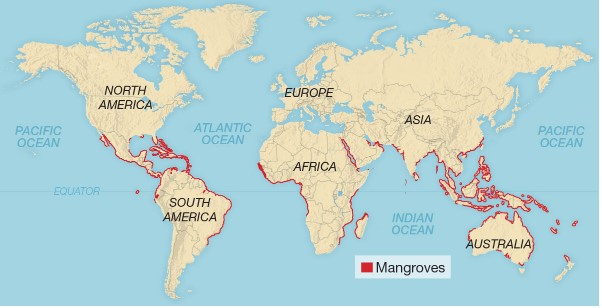Mangroves
2022 NOV 19
Preliminary >
Geography > Biogeography > Mangroves
Why in news?
- A study conducted on the condition of mangroves in India by Birbal Sahni Institute of Palaeosciences(BSIP) states that by 2070, Indian mangroves will further reduce and shift by around 50%, especially in southern India, due to a decline in suitable habitats along the east and west coasts of India.
What are mangroves?
- Mangroves are a group of trees and shrubs that live in the coastal intertidal zone.
- They occur worldwide in the tropics and subtropics, mainly between latitudes 25° N and 25° S.
- Mangroves are restricted mainly to the tropical areas as they cannot tolerate the extreme cold events typical of the temperate zone.

Features of mangroves:
- Mangroves are adapted to surviving in waterlogged and anoxic soil, including slow-moving and brackish water due to some of its distinct features.
- Halophytes: Mangrove species survive by filtering out as much as 90% of the salt found in seawater as it enters their roots. Some species excrete salt through glands in their leaves.
- Water retention capacity: Mangroves store fresh water in thick succulent leaves. A waxy coating on the leaves of some mangrove species seals in water and minimizes evaporation.
- Pneumatophores: Some mangroves grow pencil-like roots that stick up out of the ground like snorkels and take in oxygen from the air. These roots allow mangroves to cope with daily flooding by the tides.
- Prop roots: Many mangrove trees have dense intertwined aerial roots that descend from their trunks and branches that stabilize and support them from battering waves and shifting tides.
- Lenticellated bark: Besides the root, oxygen enters a mangrove through lenticels, thousands of cell-sized breathing pores in the bark and roots. This helps them adapt to the low oxygen conditions.
- Viviparous: Seed pods germinate while on the tree, so they are ready to take root when they drop.
Mangroves in India:
- According to the India State of Forest Report, 2021 >> the mangrove cover in India is 0.15% of the country's total geographical area.
- Among the states and UTs, West Bengal has the highest percentage of area under total Mangrove cover followed by Gujarat and Andaman Nicobar Islands.
|
The Sundarbans is the largest contiguous mangrove forest in the world. Its name derives from the dominant mangrove species sundari (Heritiera fomes).
|
- Mangrove areas of the country are represented in the Sunderbans Tiger Reserve, Bhitarkanika, Coringa, Nelapattu, Point Calimere Wildlife Sanctuaries, Pirotan National Park and other areas.
PRACTICE QUESTION:
Consider the following statements:
1. Mangrove cover in India is approximately 5% of country’s total geographical area
2. Among the states in India, Gujarat has the highest percentage of area under total mangrove cover
Which of the statements given above is/are correct?
(a) 1 only
(b) 2 only
(c) Both 1 and 2
(d) Neither 1 nor 2
Answer
